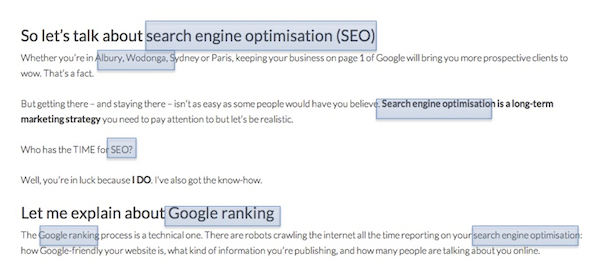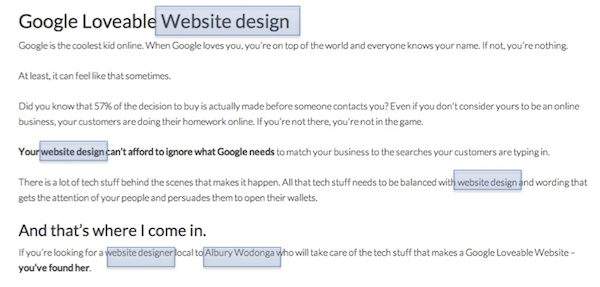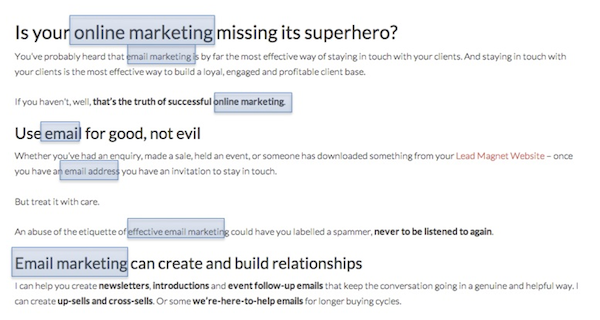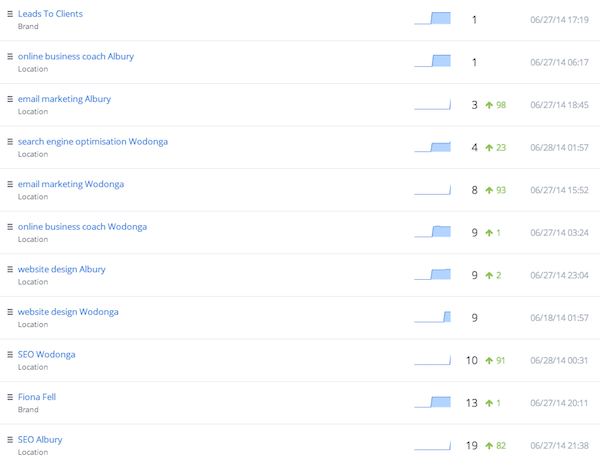Google is getting smarter and smarter all the time. Recently, the almighty Google upgraded its search algorithm to understand the semantics of searches and return relevant content that matched the context and intent of the search, not just the keywords.
So using keywords in your copywriting has become less important… or has it?
You see, while Google is now a whole lot better at understanding context and intent, you still have to give it some reasonable signals about what your content is about. Using the keywords and related keywords through your copywriting – strategically and naturally – and being relevant and useful above all; that’s what an SEO copywriter brings to the table.
This post is going to step through a case study of a recent client of mine: Leads to Clients. I’m going to show you what I did and what happened soon after. The results will surprise you.
Spoiler: One of her pages jumped 98 ranking positions to be ranked third, on page one – in three days!
Table of Contents
The challenge
Fiona Fell, founder of Leads to Clients, approached me in Feb 2014.
“I say I could use a health check, but I have very limited things to check. I’m not even sure my own website has a pulse. I want my site to dominate all my local keywords, then grow higher with keywords further afield.”
Fiona markets herself as a self-professed geek who translates web-speak for service professionals that want to grow their business online. She creates Google-friendly and lead-magnet websites, helps businesses boost and track their search engine ranking and creates relationship-building email marketing campaigns.
As you can see… online stuff that people need to do to grow their business, coupled with some great strategic advice.
Fiona has been busy building her customer base thanks to an excellent reputation, but if you googled the services she offers, looking for a provider in her area, she was nowhere to be seen.
She had a number of specific services to promote and was targeting service providers local to Albury and Wodonga. As SEO is part of her service offering, she was able to give me the keywords and phrases she wanted to “dominate”.
How I prepared my SEO copywriting
Organising the sitemap
I asked Fiona whether she planned to have a page for each service. She did and that was the first step to SEO glory.
Separating products and services into distinct pages will stop you from confusing searching engines with a page of competing topics. Google is really smart (all hail) but the easier it is for Google to work out what your page isabout, the more SEO loving you’ll get in return.
If your website development budget doesn’t stretch to having separate pages or you just don’t have that much to say, don’t worry. Pick your most profitable products or services and shine a spotlight on them, and just work a bit harder on other parts of your SEO strategy for the other products and services.
Get the keywords sorted
As I mentioned, SEO is part of what Fiona offers so she was able to give me some keywords for each page. Fiona gave me a long list of keywords focussed around her services. I pointed out that to really be effective we needed to narrow that list down to one or two keywords per page.
The primary keyword focus for each page was:
Google-lovable websites: website design
Lead-magnet websites: website design
Google rank boosting: SEO, search engine optimisation
Google rank tracking: SEO, search engine optimisation
Email marketing: email marketing
Unsticking strategy session: online business coach
I also noted related keywords for each page: words that you would normally use when talking about the topic but they wouldn’t necessarily bring lots of traffic. For example, on the SEO-related pages I would also use phrases like Google ranking, SEO ranking, SEO tracking, search engine ranking.
When you use related keywords in your copy you avoid the tendency for keyword-stuffing (repeating the same keyword over and over again).
How I applied my SEO copywriting
When I write copy with an SEO focus, I forget about the SEO on the first draft. I write for the customers, I write for the brand, I write to make a connection between them to motivate action.
Then, I look for ways to optimise the copy.
When you do your keyword research first to see the kind of queries people are typing in (so what their intent is), you’ll have those phrases bouncing around in your head. When you write relevant, helpful content that keeps the reader in mind, you’ll instinctively use relevant phrases – which will more than likely be your keywords!
Make vague phrases more concrete
One the first pass, I look for high-level phrases to make more specific and use my keywords. Phrases like “our products” and “our services” are prime candidates. Even “I can help” can be made more specific using “with…” and a keyword-rich benefit.
I ask myself, can this phrase be relevant to another product, service or business? If the answer is yes, it needs to be more specific.
Use keywords strategically
Remember, search engines can’t see your webpage. They look for simple signals in your copywriting and code to figure out what you’re saying, and if it’s relevant.
So don’t just write more copy. Use your keywords and related keywords strategically, putting them in:
- Headlines and sub-headings
- Lists
- Links between pages
- Unique page title tags
I also try and ensure the keywords are mentioned in the first and last few hundred words. I won’t force it, but I try.
The key to all SEO copywriting is not to overdo it. I’ll never wedge a keyword into a headline if it’s going to sound LAME. Why? Because I risk turning the reader off and them clicking off.
Here’s a few examples of my SEO copywriting for Leads to Clients:

Figure1: This is the opening to the Google Rank Boosting page. I’ve focused on the key phrases “search engine optimisation”, “SEO” and the location but also used lots of related language to avoid it feeling stuffed.

Figure2: This is the opening to the Google-Loveable Website Design page. You can see that I’ve used the keyword “website design” but it doesn’t feel forced.

Figure3: This is the opening of the Stay in Touch Email Marketing page. This page showed the biggest leap in results, which you’ll read about further on. I focused on “email marketing” but also used lots of words related to emailing and online marketing.
It’s not always easy to include a location in the copywriting so I always include it in the title tag for each page. For Leads to Clients, I managed to work it into the copy as well, which I admit I’m pretty chuffed about.
![]()
What about the non-service pages?
 The pages Fiona needs to pop up for searches are her services pages, so they were the main focus of my work as an SEO copywriter. Her about me pages, contact page and homepage were all about making a connection.
The pages Fiona needs to pop up for searches are her services pages, so they were the main focus of my work as an SEO copywriter. Her about me pages, contact page and homepage were all about making a connection.
That doesn’t mean I didn’t use her keywords but they were a secondary concern to making sure the reader understood what she offered and what she would be like to work with.
Results of my SEO copywriting efforts
This is the exciting part.
When I’m talking to a new client about SEO copywriting and they mention wanting to boost their ranking as a primary goal, I always explain thatoptimised content is just one part of a strong SEO strategy. But it still matters.
I also explain that how quickly Google notices your shiny, new optimised content is really up to Google.
And yet… three days after the content was live, Fiona emailed me this:

Look at all the green arrows!
As you can see, just three days after the new optimised content was loaded onto the Leads to Client site (with no other SEO having been done) Fiona’s ranking on her nominated keywords was up up up.
“Email marketing Albury” was up 98 positions – putting her at number three on page one.
“Email marketing Wodonga” had similar success, jumping was up 93 positions –putting her at number eight on page one.
“Search engine optimisation Wodonga” and “SEO Wodonga” blasted onto page one – boosting 23 and 91 positions respectively.
And finally, Leads to Clients nudged across from page two to page one for “website design”.
I whooped around my living room and asked Fiona how she felt.
“Absolutely stoked. I was hoping for the new content to be noticed, (aka Google to come back and notice things had changed) but was NOT expecting such a radical jump up the results.”
“Wonder what will happen when I add style to the site and add all sorts of whiz-bang goodies to get email opt-ins, AND start blogging!”
So, no blogging, no PPC, no social media campaigns. Just SEO copywriting doing its job.
So the next time you hear someone say SEO copywriting isn’t worth paying for or it isn’t a skill worth having, send them this post.
And if you’d like to learn my techniques in a lot more detail, sign up to hear about my copywriting master classes.
About the author: Belinda Weaver
Belinda Weaver is the founder of Copywrite Matters and copywriter behind The Copy Detective blog. If you want to be the FIRST to hear when her next copywriting master class course (so you can write better copy, faster) get on the master class prelaunch list.
Join me on www.copywritematters.com.au




